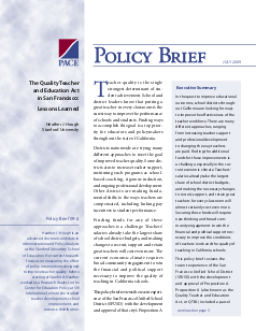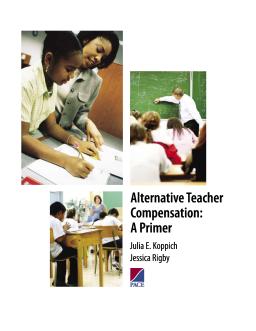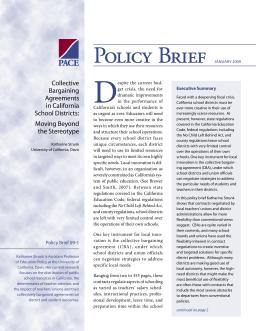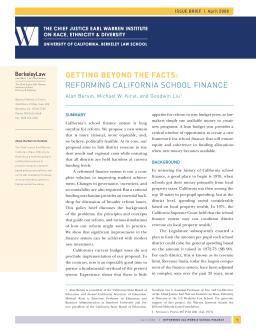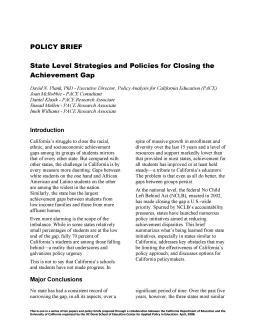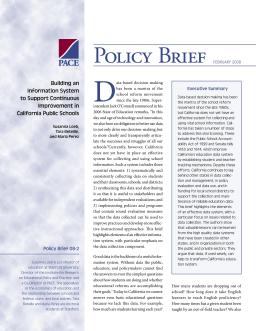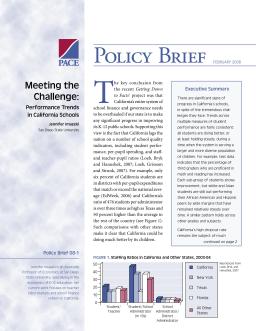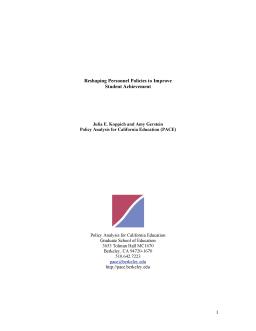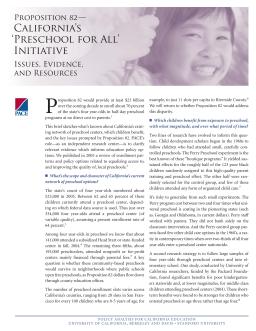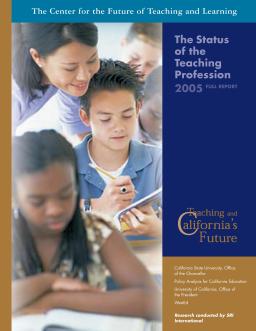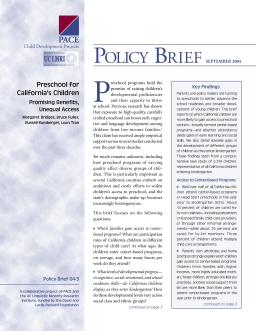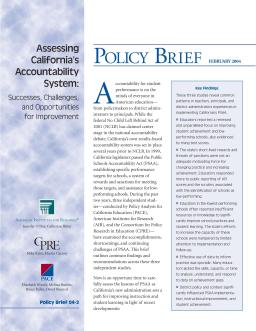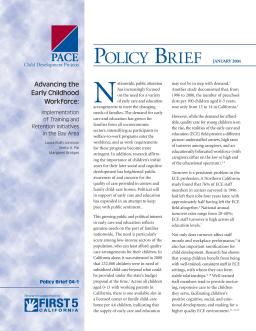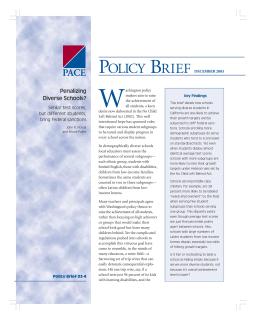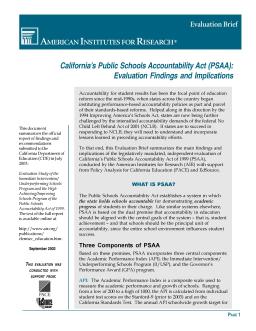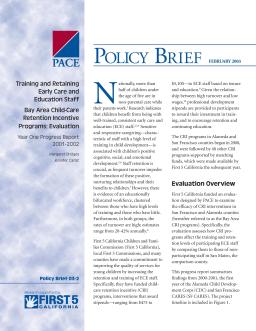Published
Summary
This brief examines the use of student test scores in teacher evaluations in CA. It argues that current evaluation methods are not effective, and that alternative methods of measuring teacher effectiveness, such as peer evaluations and student surveys, should be explored. The brief also discusses the potential consequences of over-reliance on test scores, such as teaching to the test and neglecting non-tested subjects. It concludes that teacher evaluations should be designed to provide useful feedback for professional development, rather than being used solely for accountability purposes.
Published
Summary
The brief discusses California's current school funding system and how it needs to be reformed to ensure equity and adequacy for all students. The current system is inadequate, unfair, and difficult to understand. The brief recommends a new system that is transparent, flexible, and based on student needs. The new system should also be aligned with state and local priorities, and provide incentives for districts to improve student outcomes. Finally, the brief emphasizes the importance of engaging stakeholders and building public support for the new funding system.
Lessons Learned
Published
Summary
This policy brief examines the recent development and approval of Proposition A in the San Francisco Unified School District, which included a parcel tax for increasing teacher salaries, introducing flexibility to the salary schedule, and strengthening accountability for teacher performance. The author describes how the district and union worked together to increase compensation and align school district goals with teacher salaries.
A Primer
Published
Summary
The report is a primer on alternative teacher compensation, which provides information about different models for teacher pay, and analyzes the benefits and challenges of each model. It highlights the reasons for the interest in alternative compensation, such as improving teacher quality, increasing teacher retention, and addressing teacher shortages. The report also examines the potential impact of alternative compensation on student outcomes, and offers recommendations for policymakers and practitioners considering implementing such programs.
Moving Beyond the Stereotype
Published
Summary
This brief examines how Collective Bargaining Agreements (CBAs) between school districts and teachers’ unions vary across California's 464 districts, suggesting that local flexibility is being used to solve specific problems. However, CBAs in high-need student districts are less likely to include unconventional provisions. The author suggests three policy levers the state can use to ensure local flexibility is used to benefit students: sharing best practices, incentives for innovation, and sanctions for abusing flexibility.
Continuous Improvement in California’s Education System
Published
Summary
This policy brief emphasizes the need for California's education system to become a continuously improving system that fosters innovation, measures the impact of policies and practices, and learns from experience. The authors identify key features of a continuously improving system, including clear goals, reliable data, change-supportive capacity, flexible decision-making, and aligned incentives. They explain how each of these features supports continuous improvement and highlight the differences between the current education system and a continuously improving one.
Reforming California School Finance
Published
Summary
This policy brief proposes a more rational and equitable school finance system for California that links district revenue to student needs and regional costs. The proposal aims to ensure that all districts are held harmless at current funding levels while providing essential backdrop for broader reform issues. The brief discusses the problems with the current finance system, the principles and concepts that guide the reform, and simulations of how it might work in practice. The report shows that significant improvement in the finance system can be achieved with modest new investment.
Published
Summary
California faces significant challenges in closing the achievement gap between different student groups, including wide disparities based on race, ethnicity, and socioeconomic status. While progress has been made, the gaps persist. This report summarizes what is being learned from state initiatives to reduce these disparities, addresses obstacles limiting effectiveness, and provides options for policymakers to address this urgent issue.
Published
Summary
This policy brief proposes policy recommendations to improve teaching quality in California schools by experimenting with new policies in professional development, evaluation, compensation, and teacher career structure. It includes descriptions of innovative programs in each area being implemented across the US. The state can play a critical role in providing incentives, evaluating effectiveness, and developing partnerships to share knowledge about effective policies and practices.
Published
Summary
California needs to improve its education data system to collect and use vital school information for continuous improvement. The state is behind in data collection, management, evaluation, and funding compared to other states. The report suggests learning from other high-quality data systems and using data to transform California's education system.
Performance Trends in California Schools
Published
Summary
California's education system faces financial and demographic challenges, with per pupil spending below the national average and a majority of students living in poverty or English Learners. However, recent state and national assessments show improved academic performance, particularly for poor and minority students. More students are taking advanced math and science courses and meeting university admission requirements. While the state falls short of its goals, systemic reforms are needed, but the gains are a result of hard work and commitment from California's educators.
Data Systems and Policy Learning
Published
Summary
This report advocates for a continuous improvement approach to education in California, emphasizing the need for a comprehensive data system to inform decision-making and evaluation at all levels of the education system. It also recommends the use of research-based practices and the development of partnerships between schools and community organizations to support student success. The report emphasizes the importance of equity and suggests strategies for addressing achievement gaps and providing more resources to under-resourced schools.
Published
Summary
This report examines personnel policies in California schools and their impact on teacher quality and student outcomes. It finds that many districts have ineffective policies and recommends reforms, such as performance evaluations and professional development. The report also emphasizes the need to attract and retain high-quality teachers, provide support for them, and promote collaboration between districts and unions.
How the First Semester Matters for Community College Students’ Aspirations and Persistence
Published
Summary
This policy brief argues that expanding access to community college alone will not prepare California's workforce for the 21st century. It shows that many high school graduates who enter community college with the goal of transferring to four-year colleges do not make it through their first semester with their goals intact. Providing additional guidance and support during the first semester could improve student persistence and transfer rates, as the first semester is crucial in shaping students' post-secondary academic careers.
Options for California
Published
Summary
This policy brief examines accountability in California's education system, calling for a comprehensive approach that measures student outcomes and addresses systemic factors. The authors emphasize stakeholder engagement and local capacity building, and suggest a balanced approach that promotes continuous improvement for California's diverse student population.
Options for California
Published
Summary
This policy brief advocates for the expansion of career-technical education (CTE) in California's high schools through a CTE/multiple pathways approach. The authors argue that this approach integrates academic and occupational content, is more effective for students, and addresses criticisms of high schools. They propose building on existing CTE practices and providing funding, technical assistance, professional development, curriculum development, work-based learning opportunities, and data monitoring to support the expansion of CTE/multiple pathways.
Issues, Evidence, and Resources
Published
Summary
This policy brief provides an overview of California's existing network of preschool centers and the potential impact of Proposition 82, which would provide funding for half-day preschool programs for 70% of the state's four-year-olds. PACE, an independent research center, aims to clarify evidence informing education policy options. A 2005 PACE review focused on enrollment patterns and policy options for improving access and quality of local preschools.
Full Report
Published
Summary
The Teaching and California's Future initiative provides policymakers with data on the teacher workforce and labor market. The initiative's annual report details teacher development policies and their impact on teacher quality and distribution. The goal is to help policymakers make informed decisions about strengthening the state's teacher workforce.
Published
Summary
The quality of teaching and the need to expand California's ranks of excellent teachers demand urgent public discussion. We must attract the best and brightest to teaching, prepare them effectively, and support and retain them. Solutions require bipartisan leadership, not spin. This report presents the latest research and projections, highlighting that while some numbers are improving, we're likely to face severe shortages again soon and the pipeline for recruiting, preparing, and training teachers has substantial problems.
Promising Benefits, Unequal Access
Published
Summary
This policy brief examines how California's education governance has shifted from local control to centralized, administrative accountability over the past 30 years, including changes in school finance. It primarily focuses on categorical program funding, assessing its impact on equity, adequacy, flexibility, choice, efficiency, predictability, stability, rationality, and accountability. The authors also propose alternative models to the existing system of categorical funding.
Successes, Challenges, and Opportunities for Improvement
Published
Summary
California's accountability system, PSAA, has been examined by three independent studies, revealing five key issues. The system established specific performance targets, rewards, and sanctions for schools, but budget constraints and differences with NCLB require changes. The STAR testing and school assessment system needs review, and Governor Schwarzenegger proposed simplifying the school finance system. The brief aims to inform policymakers, clarify complex accountability issues, highlight educators' views, and outline four major implications.
Implementation of Training and Retention Initiatives in the Bay Area
Published
Summary
The early care and education (ECE) profession faces staffing problems due to understaffed centers, high turnover rates, and an educationally bifurcated workforce. To mitigate this issue, programs like the California Childcare Retention Incentive (CRI) provide monetary stipends to ECE professionals who meet tenure and education requirements. This policy brief summarizes findings from a two-year evaluation of CRI programs in Alameda and San Francisco counties, focusing on themes relevant to Year 2 implementation.
Similar Test Scores, but Different Students, Bring Federal Sanctions
Published
Summary
California schools with more demographic subgroups are less likely to meet their growth targets and face federal sanctions, even when students have similar average test scores. Schools with many low-income Latino students are particularly unlikely to hit growth targets. Is it fair to label diverse schools as failing when their overall achievement level is not necessarily lower?
Evaluation Findings and Implications
Published
Summary
This report evaluates California's Public Schools Accountability Act of 1999, which aimed to hold schools accountable for student results. The brief summarizes the main findings and implications of the legislatively mandated, independent evaluation of the Act, with the aim of helping states understand and learn from preceding accountability efforts.
Bay Area Childcare Retention Incentive Programs Evaluation—Year One Progress Report, 2001–02
Published
Summary
The First 5 California Children and Families Commission has funded the Childcare Retention Incentive (CRI) to improve the quality of early care and education (ECE) staff training and retention. An evaluation funded by First 5 California assesses the efficacy of CRI programs in San Francisco and Alameda counties. This report summarizes the preliminary findings from the first year of the Alameda Child Development Corps and San Francisco CARES programs, which examine whether CRI recipients are more likely to participate in training and be retained compared to non-participating ECE staff.


